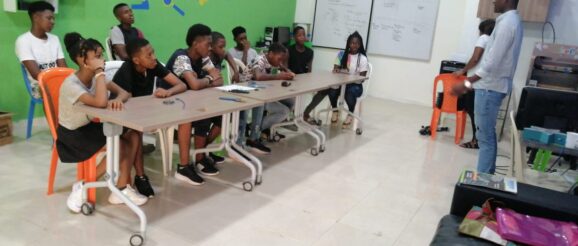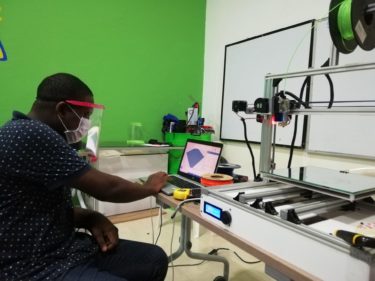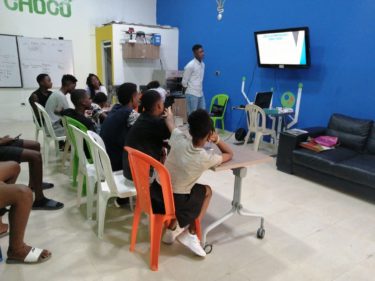With Govt Nowhere To Be Found, Colombian Robotics School Takes Innovation into its Own Hands

Chocó’s School for Robotics teaches children to think disruptively, in order to stimulate the socio-economic development of different ecosystems in the Pacific region.
Tucked away on Colombia’s Pacific coast, the department of Chocó is home to the highest levels of unemployment in the country at 22%, according to the National Administrative Department of Statistics (DANE).
Chocó is also one of the poorest departments in the country, with a 45% poverty rate, according to DANE data from 2018.
“People from Chocó have something very important. Despite being abandoned [by the government], they are very resourceful” — Jimmy García
According to Jimmy García, the director and founder of Chocó’s School for Robotics, there is still a lot of work to be done to break the “historic chains of slavery” that are still present in the region, which he claims suffers from the absence of the Colombian state.
Like in most cities, social class dictates the path that young people follow in Quibdó, the capital city.
For low-income families, young people have “a marked path, which makes them very vulnerable,” he said. This often leads them to work in culture, becoming musicians or dancers, or sports players.
“Many go on to become footballers,” García added. Others could end up working in carpentry, commerce, or sometimes in mining.
For the middle classes, university is an option, but local job prospects are often weak, said García. This is why many recent graduates from Chocó often have to leave the area in order to pursue their dream jobs.
However, by training up the next generation of young people in the fields of STEM and innovation, García is hoping to change their life prospects.
Why García chose to return home
Born and educated in Chocó, García had the opportunity to leave his hometown in search of work after graduating from university with a degree in systems engineering.
He found himself in the city of Medellín, where he worked as a school teacher from 2007 until 2015. During that time, he founded a robotics club for children aged 11-12 in one of the city’s low income neighborhoods, known as comunas, in the hope of changing their lives.
Having won funding from a local science museum and Ruta N — Medellín’s center for innovation — his team was able to start travelling around the world to enter robotics competitions.
“Very quickly, I started to notice the extraordinary change in these boys and girls,” García said, who had it not been for the opportunity, would have been destined to follow very different paths in life.
But one day, when the team was competing in Mexico, García had an experience that put his vision into perspective. He was asked about a t-shirt he was wearing with “Chocó” on the back.
Explaining to the stranger that Chocó, Colombia, was the department he was from, forced him to ask himself why he wasn’t representing his home city at competitions like this.
He knew why. Because there wasn’t a team. Because Chocó is one of the most poorly connected areas of Colombia. Because roads leading to Chocó are notorious for landslides and dangerous because of organized crime. And flights are expensive.
But for García, this simply wasn’t good enough.
Soon after, he quit his job in Medellín and returned home to Chocó.
Education for change
Initially, it took a huge amount of perseverance to push through a lack of interest from the local government and few initial funding opportunities, García said.
But eventually, thanks to the Pacific Center of Innovation — with help from local NGO Manos Visibles and the Massachusetts Institute of Technology (MIT) — in 2016, the Chocó School for Robotics was born.
“Very quickly, I started to notice the extraordinary change in these boys and girls” — Jimmy García
The school aims to offer a quality education for students aged six to eighteen in the fields of robotics, innovation and STEM. At the same time, it teaches skills such as teamwork, communication and the ability to transform small ideas into large achievements.
Besides forming teams to participate in both national and international robotics competitions, the students also work on designing tech solutions to make life easier for the community.
So far, they have designed an educational app to raise awareness of domestic violence, and a system to ensure that traffic lights in the city of Quibdó work using solar to ensure they continue to work through any of the regular power cuts.
Another idea the students pioneered was to design an early alert system to warn communities if rivers are due to rise and potentially flood, which was halted due to funding limitations.
Thanks to sponsorship from international agencies such as The United States Agency for International Development (USAID), the International Organization for Migration (IOM), the school is also to take its programs to remote areas of Colombia particularly affected by the country’s armed conflict, such as the town of Bojayá. The Canadian government and PLAN Foundation also support the school’s projects in the city of Tumaco.
In these remote areas, García hopes to be able to give young people the tools to eventually become future leaders in their territories, and “break the chains” of violence that have been recurrent for decades.
Working through challenges
The disproportionate split between girls and boys is an issue that García and his team are currently working on improving.
When the school first opened to the public, approximately 5% of the students were girls.
“The girls are afraid of getting things wrong in front of the boys,” he said.
Although now the number of girls has now risen to 10%, the school launched a program called ‘Innovation Girls,’ which this year has just accepted its fourth cohort of 20 women. It aims to teach groups of girls about STEM, but also offers training in entrepreneurship and empowerment.
Transport is also a problem that continues to affect the school’s robotics team when it wants to participate in competitions, because given that land transport is often not an option, they have to travel by plane, which is costly. Getting hold of equipment is also sometimes problematic, García explains.
But the students don’t let these barriers obstruct their progress.
Last year, for example, the robotics team represented Colombia in RoboRAVE International, a robotics competition that took place in China, where they were placed among the top 20.
And, although the school is currently closed to prevent the spread of COVID-19, with education having moved online, the students are using 3D printing to produce protective masks for local frontline healthcare workers.
“People from Chocó have something very important,” he said. “Despite being abandoned [by the government], they are very resourceful.”
“And this resourcefulness can work in our favor,” he added.
Until the Colombian government makes them a priority, García believes that the energy of the Chocoan people is what will motivate them to take matters into their own hands and continue to drive the development of their region forward.
